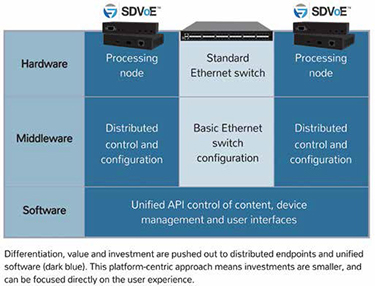
Quick Bio
Name: Justin Kennington
Title: Strategic and Technical Marketing Director
Company: AptoVision
Overtime: The Software Defined Video Over Ethernet (SDVoE) Alliance will debut at Integrated Systems Europe, and will offer extensive hands-on training in how to design, configure, and manage SDVoE networks.
In the realm of the traditional matrix switch, most of the value—where manufacturers spend their resources to differentiate—is centralized in the matrix switch itself. It’s that big black or gray box that’s 14RU tall (or more!) and consumes the huge majority of a system budget. These monoliths cost tens of thousands of dollars to buy, and the product lines cost tens of millions to develop. Teams of engineers spend many years designing high-speed circuit boards, mechanical enclosures with complex modular I/O cards, cooling systems, and lots and lots of complex firmware to make all the parts and pieces function. Meanwhile, the endpoints are all pretty much the same—HDMI on one side, category cable on the other.

With HDBaseT extenders available for less than $200, it’s clear that the value has been driven out of these commodity devices. With so much effort focused on building the matrix switch monsters—which are only differentiated by port count and speed—little focus is applied at the software layer. Just a few basic commands to make routes, maybe configure an EDID.
As the pro AV industry makes its transition away from those proprietary behemoths toward a world of IP-based distribution, the value is decentralized. The switchgear itself is replaced by commodity ethernet switches. These devices are designed by the datacenter industry to move as many bits as possible, as efficiently and reliably as possible. And the economies of scale involved exert huge downward price pressure.
This means that the resources AV manufacturers spend on building giant matrix switch boxes will be freed up to deliver value elsewhere in the system. With the central switching and distribution gear commoditized, value and differentiation can be focused on the endpoints, and on new software applications to create customized user experiences. Since the catalog of required pieces is smaller (no multi-sized chassis, no I/O cards), manufacturers large and small can focus their creativity on endpoints with unique form factors and features like video processing—whether simple upscaling and downscaling, or advanced networks of distributed video wall controllers.
As innovation moves up the stack—away from complex proprietary hardware and toward software applications—we can start to build dedicated and standardized software platforms. This allows new types of thinkers to enter the product development arena—software developers who are decoupled from the hardware itself.

The technology community has seen this progression many times before. Observe the transformation of the telecom industry from circuit switches, to IP distribution, to the hardware/software platform offered by today’s smartphones. Today, the network is certainly a required piece of infrastructure, but the real value—what attracts buyers—is the design of the endpoints (phones) and the software (apps) that run on their platform (iOS, Android). The power of a platform is its inclusiveness. No one at Apple had to think, “I’ll build a piece of hardware you carry in your pocket that lets you hire a stranger’s car!” Instead, they built a powerful software communications platform (based on ethernet, not coincidentally) and someone else came along and thought, “I know what I can do with this!” Thus, Uber was born.
This platform-centric approach will enable a new creative renaissance for pro AV, but it means that system designers and contractors will need new ways to think about and understand AV systems. By utilizing the ethernet network instead of point-to-point links, the logical (functional) architecture of the network can be decoupled from the physical architecture of the system. Think about that: in a point-to-point world, if you want to move signal from A to B, you must run a new wire from A to B. In the IP world, wherever there is a network drop (provided, of course, by a cable) you will be able to move video between that drop and any other on the network.
These new AV systems will require new types of knowledge for design and configuration. Bandwidth management, VLAN tagging and prioritization, and multicast traffic routing and management are new areas that need to be mastered. The integrators and contractors ready to take on this new knowledge set will be the future leaders of the industry as it undergoes this inevitable change.
Besides learning about design and configuration of ethernet networks, it will be more and more necessary to learn about the software that enables these new applications for video processing and distribution. This will enable system designers to better tailor systems to their users’ needs.
To help accelerate and ease this transition, a new industry alliance is forming, and debuting at Integrated Systems Europe (February 2017 in Amsterdam). The Software Defined Video Over Ethernet (SDVoE) Alliance will offer extensive hands-on training in how to design, configure, and manage SDVoE networks. This training will also debut at ISE 2017 and then quickly expand across the globe to help designers, integrators, and consultants understand this new hardware and software platform.
